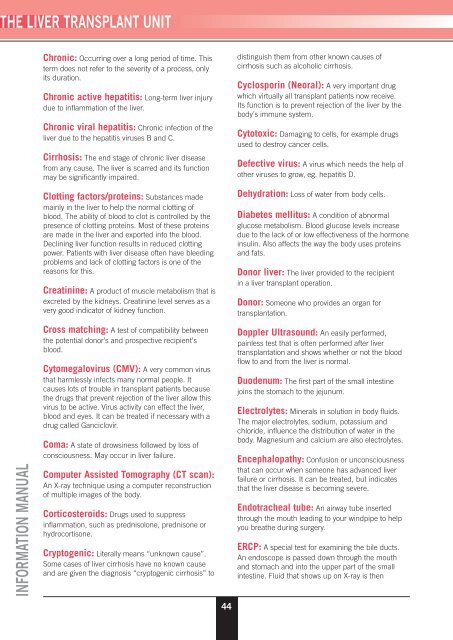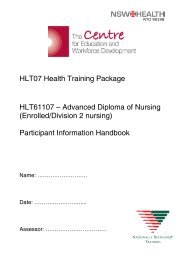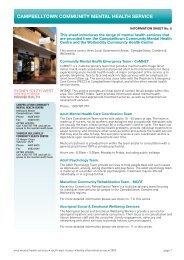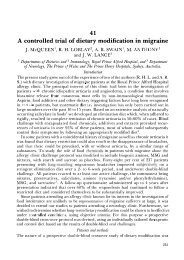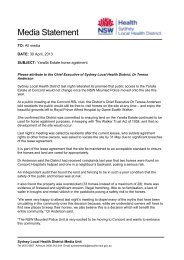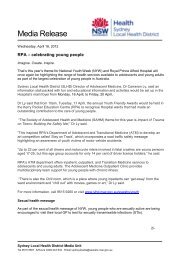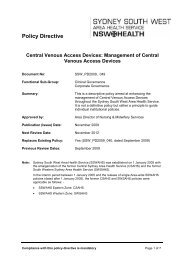information manual - for liver transplant recipients and their families
information manual - for liver transplant recipients and their families
information manual - for liver transplant recipients and their families
- No tags were found...
Create successful ePaper yourself
Turn your PDF publications into a flip-book with our unique Google optimized e-Paper software.
THE LIVER TRANSPLANT UNITINFORMATION MANUALChronic: Occurring over a long period of time. Thisterm does not refer to the severity of a process, onlyits duration.Chronic active hepatitis: Long-term <strong>liver</strong> injurydue to inflammation of the <strong>liver</strong>.Chronic viral hepatitis: Chronic infection of the<strong>liver</strong> due to the hepatitis viruses B <strong>and</strong> C.Cirrhosis: The end stage of chronic <strong>liver</strong> diseasefrom any cause. The <strong>liver</strong> is scarred <strong>and</strong> its functionmay be significantly impaired.Clotting factors/proteins: Substances mademainly in the <strong>liver</strong> to help the normal clotting ofblood. The ability of blood to clot is controlled by thepresence of clotting proteins. Most of these proteinsare made in the <strong>liver</strong> <strong>and</strong> exported into the blood.Declining <strong>liver</strong> function results in reduced clottingpower. Patients with <strong>liver</strong> disease often have bleedingproblems <strong>and</strong> lack of clotting factors is one of thereasons <strong>for</strong> this.Creatinine: A product of muscle metabolism that isexcreted by the kidneys. Creatinine level serves as avery good indicator of kidney function.Cross matching: A test of compatibility betweenthe potential donor’s <strong>and</strong> prospective recipient’sblood.Cytomegalovirus (CMV): A very common virusthat harmlessly infects many normal people. Itcauses lots of trouble in <strong>transplant</strong> patients becausethe drugs that prevent rejection of the <strong>liver</strong> allow thisvirus to be active. Virus activity can effect the <strong>liver</strong>,blood <strong>and</strong> eyes. It can be treated if necessary with adrug called Ganciclovir.Coma: A state of drowsiness followed by loss ofconsciousness. May occur in <strong>liver</strong> failure.Computer Assisted Tomography (CT scan):An X-ray technique using a computer reconstructionof multiple images of the body.Corticosteroids: Drugs used to suppressinflammation, such as prednisolone, prednisone orhydrocortisone.Cryptogenic: Literally means “unknown cause”.Some cases of <strong>liver</strong> cirrhosis have no known cause<strong>and</strong> are given the diagnosis “cryptogenic cirrhosis” to44distinguish them from other known causes ofcirrhosis such as alcoholic cirrhosis.Cyclosporin (Neoral): A very important drugwhich virtually all <strong>transplant</strong> patients now receive.Its function is to prevent rejection of the <strong>liver</strong> by thebody’s immune system.Cytotoxic: Damaging to cells, <strong>for</strong> example drugsused to destroy cancer cells.Defective virus: A virus which needs the help ofother viruses to grow, eg. hepatitis D.Dehydration: Loss of water from body cells.Diabetes mellitus: A condition of abnormalglucose metabolism. Blood glucose levels increasedue to the lack of or low effectiveness of the hormoneinsulin. Also affects the way the body uses proteins<strong>and</strong> fats.Donor <strong>liver</strong>: The <strong>liver</strong> provided to the recipientin a <strong>liver</strong> <strong>transplant</strong> operation.Donor: Someone who provides an organ <strong>for</strong><strong>transplant</strong>ation.Doppler Ultrasound: An easily per<strong>for</strong>med,painless test that is often per<strong>for</strong>med after <strong>liver</strong><strong>transplant</strong>ation <strong>and</strong> shows whether or not the bloodflow to <strong>and</strong> from the <strong>liver</strong> is normal.Duodenum: The first part of the small intestinejoins the stomach to the jejunum.Electrolytes: Minerals in solution in body fluids.The major electrolytes, sodium, potassium <strong>and</strong>chloride, influence the distribution of water in thebody. Magnesium <strong>and</strong> calcium are also electrolytes.Encephalopathy: Confusion or unconsciousnessthat can occur when someone has advanced <strong>liver</strong>failure or cirrhosis. It can be treated, but indicatesthat the <strong>liver</strong> disease is becoming severe.Endotracheal tube: An airway tube insertedthrough the mouth leading to your windpipe to helpyou breathe during surgery.ERCP: A special test <strong>for</strong> examining the bile ducts.An endoscope is passed down through the mouth<strong>and</strong> stomach <strong>and</strong> into the upper part of the smallintestine. Fluid that shows up on X-ray is then


